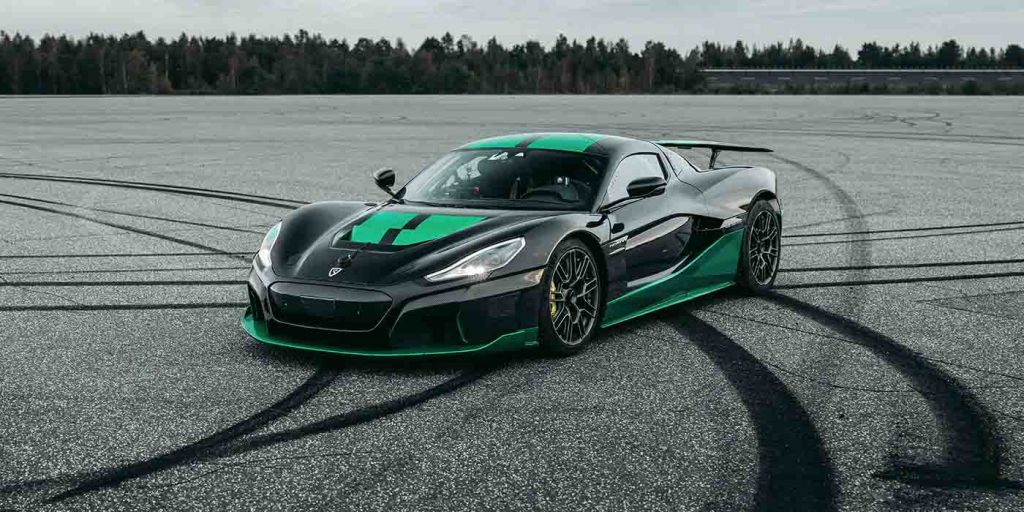
After smashing dozens of world records with its Nevera hypercar throughout the past year, Rimac Group decided to have a little fun before the end of 2023 and snag one more… in reverse. As you can see in the video below, the Rimac Nevera is faster backwards than many other vehicles going forward. What a flex.
Since 2009, Rimac Automobili has continued to bless us EV enthusiasts some of the most exciting and technologically advanced electric hypercars in the world. Rimac’s first EV, the Concept_One, was introduced in 2016 and was considered one of the world’s fastest production vehicles at the time, although its assembly line saw less than ten vehicles.
It was followed by the Concept_Two in 2018, which eventually evolved into its production form – the Nevera – for which Rimac promised a larger scale of production of 150 units costing more than $2 million each.
Nevera deliveries are now underway, but just in case potential customers needed any more convincing to shell out for the hypercar, Rimac has continuously been chasing world records in the EV.
This past May for example, Rimac garnered 23 performance world records in a single day – a record in itself – proclaiming the Nevera as “the ultimate record-breaking hypercar.” In August, Rimac Group secured the speed crown at Nürburgring, breaking the lap record for a production EV by a whole 20 seconds.
Now, Rimac Group is running the world record chasing back… quite literally, as it is celebrating a new speed record, driving the Nevera in reverse.
Rimac Nevera snags world record for fastest car in reverse
You’ve gotta be a pretty confident team of engineers when you decide you’re bored with the 20+ world records you’ve already achieved accelerating and braking while going forward and decide it’s time to start winning titles backwards.
It feels equivalent to Michael Jordan taking free throws with his eyes closed. A major flex, but an impressive one if you can back it up. Rimac Group is certainly backing it up and has another Guinness World Record plaque to add to its trophy case.
The record achieving run took place on October 7 at the Automotive Testing Papenburg facility in Germany – the same location the Rimac Nevera accomplished its 20+ record day. Its latest feat was witnessed by Guinness World Records and verified using data measured by Dewesoft. During the run piloted by Rimac test driver Goran Drndak, the Nevera was able to achieve a top speed of 171.34 mph (275.74 km/h) in reverse. Drndak spoke:
On the run itself, it definitely took some getting used to. You’re facing straight out backwards watching the scenery flash away from you faster and faster, feeling your neck pulled forwards in almost the same sensation you would normally get under heavy braking. You’re moving the steering wheel so gently, careful not to upset the balance, watching for your course and your braking point out the rear-view mirror, all the while keeping an eye on the speed. Despite it being almost completely unnatural to way the car was engineered, Nevera breezed through yet another record.
Because the drivetrain of the Nevera has no gears, its four individual electric motors can deliver nasty acceleration both forwards and backwards, something the Bugatti Rimac engineers toyed with leading up to the latest record setting track day. Per Nevera’s chief program engineer Matija Renic:
It occurred to us during development that Nevera would probably be the world’s fastest car in reverse, but we kind of laughed it off. The aerodynamics, cooling and stability hadn’t been engineered for travelling backwards at speed, after all. But then, we started to talk about how fun it would be to give it a shot. Our simulations showed that we could achieve well over 150 mph but we didn’t have much of an idea how stable it would be – we were entering uncharted territory.
As we’ve reported in the past, the “Time Attack” livery version of the Rimac Nevera, which achieved all these world records, is limited to 12 exclusive units globally. The hypercar itself remains limited to 150 units. Check out the record breaking run in reverse in Rimac Group’s video below.
FTC: We use income earning auto affiliate links. More.





Comments